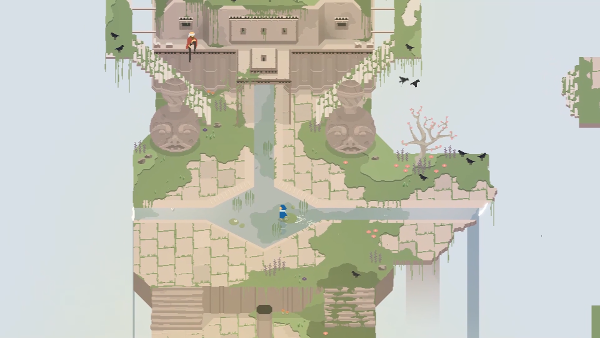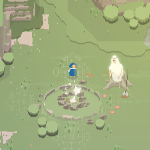Interview: ITTA’s Jacob Williams
A twin-stick adventure through fast-paced macabre beauty, developer Jacob Williams’ ITTA combines the horrors and triumphs of living with the joys of fighting bizarre enemies. With Armor Games Studios on board as the publisher, I chatted with Jacob on his process and the underlying themes that drive his work.
Erik Meyer: Itta wakes up after the murder of her family and sets out adventuring with her floating cat on the island of Jigoku; the game takes on dark themes (graveyards, evil entities, brutal combat) while maintaining a compelling sense of hope in natural settings and quiet moments, so I’m interested in your aesthetic choices and how you maintain not only a consistent art style and game universe but also combine horror and hope, even as you continue adding content. What kinds of criteria go into polishing and tuning your work to create the perfect mood?
Jacob Williams: The tone of ITTA in the beginning definitely wasn’t the same as it is now. I conceptualized the game during the lowest point of my life. I channeled everything I was feeling into ITTA and its inhabitants. It was a dark, unforgiving, brutal game with no sense of optimism.
As development continued and my mental health improved, themes of hope, love, and self-worth found their way into the game organically. My initial goal was never to combine dark and hopeful themes, and I think the game’s lore and story feel less artificial because of that.
In terms of ITTA’s aesthetic, it’s important to me that players feel a huge sense of relief and comfort after defeating a boss and returning to the overworld. Rather than having to deal with trash mobs, they can freely explore, catch up with NPCs, etc. Artistically, the only rule I have is to keep it consistent. Any artistic flaw can be passed off as a style if it’s consistent.

EM: In chess, a concept I find intriguing is in book play versus out of book play, meaning that some games entirely fall within the scope of games that have been recorded in the past, and occasionally, entirely new moves or patterns happen that revolutionize play. If no new kinds of play are developing, games are often labeled ‘solved games’, meaning there is a clear best way to play. As a developer, you’re creating, much as an author does in writing a novel or a painter does on a canvas, so within twin-stick experiences like the one you’re making, what do you see developing and changing the status quo within indie titles? How do you see yourself finding new ways to narrate, change in-game mechanics, or incorporate menus?
JW: I definitely think I’m doing something relatively new conceptually rather than mechanically. I’ve always loved twin-stick shooters and bullet hell games for their minute to minute gameplay, but I’d rather play a sprawling open world adventure any day of the week. I want to give the frantic combat of the former more thematic weight and meaning that the latter can offer.
Outside of the actual gameplay mechanics, I want players to play the game exactly how they want. The game can be beaten while missing or avoiding about half the content including an entire area, NPC stories, bosses, weapons, etc. This will result in a more upsetting ending, as well, but everything has consequences. In the end, I want the game world to feel indifferent to the player; nothing is going to guide the player to success.
EM: To put it lightly, your bosses are pretty sweet (The Ancient Cosmonaut is a personal favorite), so what takes the majority of your time as you design this aspect of your game, and what constitutes a good and challenging boss, to your view?
JW: Animation is easily the biggest time suck when it comes to bosses! It’s important to me that people like the aesthetic of ITTA though, so spending 12 hours on a boss intro is a pretty good waste of time.
As far as gameplay goes, the most important thing to me is that a boss doesn’t feel artificially difficult. My main goal is to make players feel like they’re barely surviving the fight from the moment it begins. In reality, there are several mechanics in place to keep things fair and keep players from getting frustrated. I want players to get close to frustration and then, just before that moment, kill the boss and have a huge sense of relief.

EM: Do you see a wide variety of weapon styles as a way to encourage different kinds of play, or do you engineer maps with a sequential learning curve that incorporates a variety of challenges, thusly requiring more and more tools to resolve the goals in any particular area? Similarly, as a developer, what constitutes balance and solid execution within those respective design goals?
JW: The variety of weapons is purely for the player to find a playstyle that they enjoy. The game can be beaten with only the revolver if the player wishes. Using a revolver or shotgun will give a typical twin-stick shooter experience but weapons like the bastard sword and scythe completely change the feel of the fight. Each weapon is simply a sidegrade with it’s own playstyle.
My only criteria for keeping a weapon balanced is that during playtesting every boss has killed me while retaining a majority of their health and that I’ve killed the boss without taking any damage. As long as both of those happen, then I can assume that nothing is over or underpowered.
EM: Instead of keeping the project a fairly guarded secret like many larger developers, you share a great deal of information regarding your progress and personal journey through Twitter; as you’ve progressed through development, how have your views on engaging through social media and putting out content/sneak peaks in this way changed, and as content will undoubtedly change by the time you reach the point of release, do you have any cautionary tales to share?
JW: I’ve always been a sucker for instant feedback on content I create regardless of the medium. So, in the beginning, I think I was looking for validation, which I guess I still kind of am to a degree. After a while, rather than posting sporadically, I started putting more and more effort into the game and wanted to start building a following so that I could, at some point, run a Kickstarter.
I made it a point to work at least 4-6 hours after work every night so that I would have a gif of something new to post each day. I did this for about 4 months until my effort paid off and I was contacted by Armor Games Studios. At that point, I was so used to posting daily gifs that I’ve tried to continue that goal as closely as I can. I think a lot of devs are scared to show their in-progress work because they worry about premature judgement, but I think most people appreciate seeing how things can change throughout development.
I’m not sure if anything has changed regarding how I decide to show things on Twitter. Generally, I’ll be working on the game, notice something cool that people might like to see and upload it. I try not to overthink what I post and not be too professional, so that I can still be myself for my followers.

EM: You’ve noted the influence of Nuclear Throne, Titan Souls, and Zelda, I can see the impact of titles like Hyper Light Drifter in gameplay and maps (The Old Garden, snapshot, for example); I similarly observe the kind of excitement that comes from an Adventure Time episode in the landscape and the discoveries therein. To your eye, what makes an experience feel lived in; similarly, what kinds of actions/button presses/visuals give the most satisfaction and engagement?
JW: I think the key to making a location feel more than the sum of its parts is the implication that this place, at one time, had a purpose. Nier: Automata and the Team Ico games were all huge inspirations in that regard. Something as simple as a single stone pillar can add the air of importance to a location that was previously just grass. Though, at the end of the day, I just like the aesthetic of overgrown stuff.
Regarding satisfaction and engagement, I’m trying to give even something as small as approaching an NPC a bit of punch. Every movement, button press, and action comes with subtle or not so subtle camera lerping, glowing icons, shake, etc. I definitely want the game to feel tactile with everything the player does.
EM: Outside of music, you’re taking this project on solo, so where does this allow you to be more agile, and conversely, where is it harder to pivot quickly? Given the many elements involved in ITTA (coding, art assets, narrative, assembling in the game engine, testing/polishing etc), what does your pipeline look like, and which aspects take up the most time?
JW: The most obvious benefit of working solo is I get to avoid discussion, conflict, or compromise. Clearly, I don’t work well with others! For better or worse, ITTA is my singular vision created to the best of my abilities, excluding music of course. Early on, I considered bringing someone on to do art because I wanted to focus more on the code. I talked myself out of it though, because I know I am a little obsessive and, even though I might have to spend a day animating rather than implementing something new, I know working solo is the right choice for me at this time.
To stay focused, I keep a loose schedule at all times, but that’s subject to change if I am particularly excited about working on something that day. If I’m just following straight down a to-do list, I often find myself just staring at my computer for hours. Currently, I’m polishing up the game’s first closed alpha for playtesters.

EM: Armor Games Studios serves as the publisher for your project, so given the many platforms and methods by which games are released in 2018 (Humble Bundle, Devolver Digital, Utomik, Gog, Steam, to mention a few), what does that relationship look like, and from where you sit, what helps indie games navigate these waters without getting lost in the shuffle?
JW: I’ll forever be grateful to Armor Games Studios for taking a chance on ITTA and allowing me to work on it full time. I’m a nobody from South Carolina with zero connections to the video game industry and no released projects. All I had to back me up were a bunch of gifs on Twitter, and that was enough to get their attention.
I think the most important thing for non-established indie developers is to post their work early and frequently. Saturate the conversation with your work and people are bound to take notice eventually.
In case you missed it, here’s the trailer:




